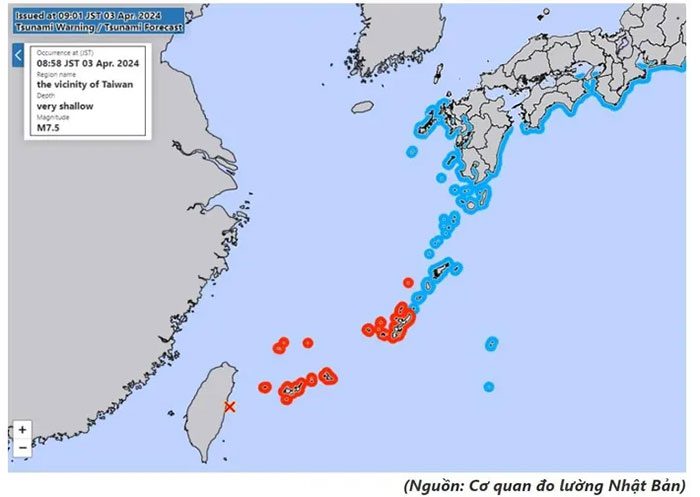A major earthquake measuring 7.5 on the Richter scale struck near Taiwan (China) just before 9 AM on Wednesday (April 3) Japan time, prompting tsunami warnings to be issued in the southern islands of Japan.
The Japan Meteorological Agency (JMA) reported that tsunami waves as high as 3 meters were expected to hit Japan’s remote islands near Taiwan (China), including Miyakojima Island. “Evacuate!” read a banner on the national broadcaster NHK.

A map illustrating the earthquake’s epicenter (X mark) and the islands at risk of tsunami attack (red). (Graphic: Kyodo).
“A tsunami is coming. Please evacuate immediately,” an NHK announcer stated. “Do not stop. Do not turn back.” The JMA reported that a tsunami wave measuring 30 cm hit Yonaguni Island at 9:18 AM.
The United States Geological Survey (USGS) indicated that the earthquake had a magnitude of 7.4, with its epicenter located 18 km south of Hualien City in Taiwan at a depth of 34.8 km. According to a witness, the strong earthquake caused power outages in several areas of the city.
“The earthquake could trigger a tsunami affecting Taiwan. The tsunami warning was issued to alert coastal residents to remain vigilant,” stated an emergency announcement from local authorities.
According to Kyodo, passengers rushed to evacuate from Naha Airport in Okinawa following the tsunami warning, and flights were also suspended at Naha Airport in Okinawa after the tremor.
Earthquakes frequently occur in Japan, which is one of the most seismically active regions in the world. Japan accounts for about one-fifth of the world’s earthquakes with a magnitude of 6 or higher.
On March 11, 2011, a magnitude 9 earthquake struck off the northeast coast of Japan. This disaster led to the world’s worst nuclear crisis at the Fukushima nuclear power plant.
Taiwan (China) is also frequently shaken by earthquakes. A 6.2 magnitude earthquake occurred near Hualien in 2018, resulting in at least 17 fatalities and over 300 injuries. In 1999, a major earthquake killed up to 2,400 people on the island.



















































